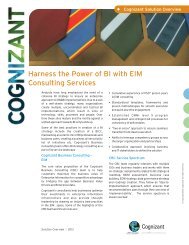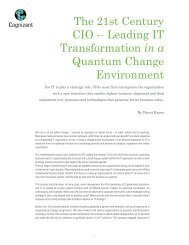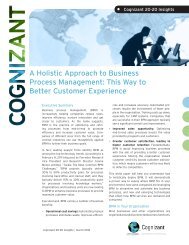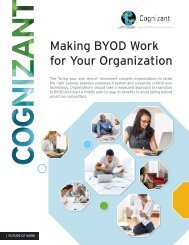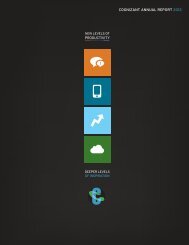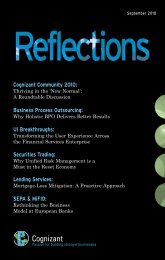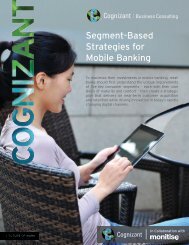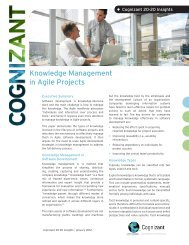XML Web Services â To Develop or Not - Cognizant
XML Web Services â To Develop or Not - Cognizant
XML Web Services â To Develop or Not - Cognizant
You also want an ePaper? Increase the reach of your titles
YUMPU automatically turns print PDFs into web optimized ePapers that Google loves.
<strong>XML</strong> <strong>Web</strong> <strong>Services</strong> – <strong>To</strong> <strong>Develop</strong> Or <strong>Not</strong> <strong>To</strong> <strong>Develop</strong>?Introduction<strong>Web</strong><strong>Services</strong> are a stack of emerging standards that describe service-<strong>or</strong>iented applicationarchitecture. They are loosely coupled, reusable software components that are distributed andprogrammatically accessible over standard Internet protocols. It may appear as a new way ofexposing the capabilities of existing applications through <strong>XML</strong> and SOAP. But behind thissimplicity we f<strong>or</strong>esee a maj<strong>or</strong> change in the software industry and business in general. Here wewill explain the reasons why such a simple initiative will revolutionize the business and mostprobably revitalize the whole e-business.New Business models on the InternetSoftware as a ServiceSoftware existed as applications that can be installed and used wherever required. Thanks to<strong>XML</strong> <strong>Web</strong> <strong>Services</strong>, a new business model, which delivers software as a service, is nowemerging. Functionalities will be delivered as a set of <strong>Web</strong> <strong>Services</strong> by the <strong>or</strong>ganizations.Organizations can become m<strong>or</strong>e focused in their c<strong>or</strong>e business, getting software services frombusinesses that operate in complimentary areas. Many of these software services can be wiredtogether to f<strong>or</strong>m a highly powered solution. The software service provider can also write manyservices that may be integrated by different application providers. It thus becomes much simplerand easy to host applications on the web and reap revenues on a usage basis. <strong>Web</strong> <strong>Services</strong> willbe the c<strong>or</strong>nerstone of the software reuse model on similar lines as objects and components.Software service aggregat<strong>or</strong>sWhen many business and technical functionalities are available as <strong>Web</strong> <strong>Services</strong>, it also willgenerate a new set of aggregat<strong>or</strong>s who will provide various <strong>Web</strong> <strong>Services</strong> under one umbrella.The advantages provided to the end user will be a single identity across multiple services andsimple payment options (Instead of payment to many different <strong>Web</strong> <strong>Services</strong>). Also, from a <strong>Web</strong><strong>Services</strong> provider perspective this is a good option, since it is easier to host the application andtake the revenue from the aggregat<strong>or</strong>.Device enabled solutionsThere is a boom in the devices sect<strong>or</strong> where a huge amount of business potential waits to betapped. Devices can be programmed to handle situations in the absence of individuals. F<strong>or</strong>instance, consider the scenario where a refrigerat<strong>or</strong> detects the amount of milk available andonce that is below the threshold, it automatically <strong>or</strong>ders milk from the market. As m<strong>or</strong>e and m<strong>or</strong>edevices hit the market, it becomes increasingly necessary f<strong>or</strong> the business to supp<strong>or</strong>t thosedevices. The new <strong>XML</strong> <strong>Web</strong> <strong>Services</strong> provide a generic infrastructure in which it can beconsumed by any device. This paves way f<strong>or</strong> a new kind of business model Business to Device(B2D).We f<strong>or</strong>esee a bloom of special range of devices called “smart devices” with the advent of <strong>Web</strong><strong>Services</strong>. A classic scenario where a smart device could be employed is depicted below. Thesmart refrigerat<strong>or</strong> detects the amount of milk in the refrigerat<strong>or</strong> and once the level goes below aset threshold value it searches the web f<strong>or</strong> the service providers who supply milk; it identifies the<strong>Cognizant</strong> Technology Solutions Page 1 of 7
<strong>XML</strong> <strong>Web</strong> <strong>Services</strong> – <strong>To</strong> <strong>Develop</strong> <strong>or</strong> <strong>Not</strong> to <strong>Develop</strong>best provider and <strong>or</strong>ders f<strong>or</strong> a supply of milk. The aggregate service provider then validates thecredit card inf<strong>or</strong>mation of the owner of the refrigerat<strong>or</strong>; it then identifies the nearest milk vend<strong>or</strong>and requests him to deliver milk. The milk is delivered and the customer gets billed f<strong>or</strong> theservice.Fig 1. Business to Device ModelBusiness IntegrationIn today’s w<strong>or</strong>ld of Internet, it is mandat<strong>or</strong>y f<strong>or</strong> any business to interact with its business partnerseffectively. There are currently many tools available in the market, which will automate theprocess of business integration. These tools provide out-of-box business integration features,which can be leveraged by the applications. But these integrations were all one to one, painfullycreated f<strong>or</strong> each business interaction, since the interaction demanded the data exchange indifferent ways and f<strong>or</strong>mats. With the advent of <strong>XML</strong> <strong>Web</strong> <strong>Services</strong>, the business integration logicbecomes much easier. Both the sides of the business open up their services as generic <strong>Web</strong><strong>Services</strong>, allowing a many to many interaction without any changes to the application. <strong>Web</strong>Service can serve typically all kinds of clients residing on any device, any platf<strong>or</strong>m. Theref<strong>or</strong>eintegration with heterogeneous systems becomes a simple task.
<strong>XML</strong> <strong>Web</strong> <strong>Services</strong> – <strong>To</strong> <strong>Develop</strong> <strong>or</strong> <strong>Not</strong> to <strong>Develop</strong>Fig 2. Existing B2B ModelThe above picture shows how businesses communicate with other businesses in the w<strong>or</strong>ld. Theywere restricted with tightly coupled mechanisms like hardwiring. Each business had to know thedata-f<strong>or</strong>matting standard of the other business with which it needed to communicate. There was aneed f<strong>or</strong> an easier way of business integration. This is a classic case of one to one businessintegration.Fig 3. New B2B ModelThe above picture depicts how the advent of <strong>Web</strong> <strong>Services</strong> has made business integration easierand simpler. Businesses can now expose their functionality as <strong>Web</strong> Service interfaces that acceptand return data as <strong>XML</strong>, an Internet standard. Other businesses, irrespective of their platf<strong>or</strong>ms,can now use these <strong>Web</strong> <strong>Services</strong>.
<strong>XML</strong> <strong>Web</strong> <strong>Services</strong> – <strong>To</strong> <strong>Develop</strong> <strong>or</strong> <strong>Not</strong> to <strong>Develop</strong>Opp<strong>or</strong>tunities f<strong>or</strong> <strong>Develop</strong>mentThe birth of <strong>XML</strong> <strong>Web</strong> <strong>Services</strong> will create tremendous development opp<strong>or</strong>tunities f<strong>or</strong> variousbusinesses.Providing inf<strong>or</strong>mation as a serviceCurrently, all the inf<strong>or</strong>mation is delivered as a static content. It is difficult f<strong>or</strong> the applications toquery against this inf<strong>or</strong>mation. <strong>XML</strong> <strong>Web</strong> Service makes a lot of sense when applications need toquery against a centralized inf<strong>or</strong>mation st<strong>or</strong>e <strong>or</strong> integrate different such inf<strong>or</strong>mation nuggets. Thecurrent static presentation model limits the end usage of the inf<strong>or</strong>mation to be just a document.<strong>Web</strong> <strong>Services</strong> liberate this inf<strong>or</strong>mation and allow reusing of this beyond the boundary of thebrowser. This gives rise to scope f<strong>or</strong> m<strong>or</strong>e inf<strong>or</strong>mation aggregations and m<strong>or</strong>e softwaredevelopment.Reusing the functionalityThere are some businesses that provide the functionality f<strong>or</strong> perf<strong>or</strong>ming a specific action, sayauthentication, credit-card validation etc. Such functionalities can be potential <strong>Web</strong> <strong>Services</strong>,which can be plugged into many applications.Business Process IntegrationIf an enterprise wants to integrate its businesses processes with its partners, each step of thebusiness process that goes across an enterprise boundary is a potential <strong>Web</strong> Service <strong>or</strong> <strong>Web</strong>Service operation.Building block service providerBuilding-block service providers provide infrastructure services ("plumbing") f<strong>or</strong> other <strong>Web</strong>applications and <strong>Web</strong> Service developers, f<strong>or</strong> example an identity service <strong>or</strong> a billing service.Aggregating <strong>Services</strong><strong>XML</strong> <strong>Web</strong> <strong>Services</strong> can provide the right combination of inf<strong>or</strong>mation to the applications byaggregating several services, thereby saving the clients the w<strong>or</strong>k of combining the existingservices themselves.
<strong>XML</strong> <strong>Web</strong> <strong>Services</strong> – <strong>To</strong> <strong>Develop</strong> <strong>or</strong> <strong>Not</strong> to <strong>Develop</strong><strong>Web</strong> <strong>Services</strong>: Can it replace any of the businessmodels on the Internet?<strong>XML</strong> <strong>Web</strong> <strong>Services</strong> by its inherent nature to interoperate with different devices, platf<strong>or</strong>ms etc.,initiates the evolution of new business models and provides value additions to the existingmodels.In a B2C scenario currently applications are mostly standalone. All the interactions like identity,payment etc. is one to one. When the user moves to a different website, all these inf<strong>or</strong>mationneeds to be given all over again. In other w<strong>or</strong>ds, every interaction is individual and the web, as awhole does not have a collective knowledge on the user identity n<strong>or</strong> preferences n<strong>or</strong> unif<strong>or</strong>mhandling of payment. <strong>XML</strong> <strong>Web</strong> <strong>Services</strong> will open a new market f<strong>or</strong> aggregate services in which,many participating <strong>Web</strong> <strong>Services</strong> will share the same identity, preferences and payment. This willensure that the current individual interaction business models on the Internet will soon betransf<strong>or</strong>med into paid services under the umbrella of some aggregat<strong>or</strong>s. Existing Internetapplications depend on online advertising and online purchase as the only source of revenue.Dot-Com failures can be attributed mainly to the fact that they did not have a clear revenuemodel. <strong>Web</strong> Service provides a distinct revenue model by which services can be charged basedon usage <strong>or</strong> on a subscription basis.<strong>To</strong>day’s B2B application integration is done by hard-wiring, messaging <strong>or</strong> by using third partybusiness integration tools all of which are basically one to one interaction between businesses.<strong>Web</strong> <strong>Services</strong> provide a simple mechanism by which business processes can interact in a manyto many relationship. There are many th<strong>or</strong>ny issues to be addressed like industry standardizationof <strong>XML</strong>, transaction, security etc. But these issues will eventually be addressed opening up amuch m<strong>or</strong>e global producer/consumer business model.The reason f<strong>or</strong> the ASP (application service providers) model not being so popular is that itdemands the users to use the application in its entirety. It becomes increasingly difficult f<strong>or</strong> theapplication to use a limited set of features that an ASP provides. . Another reason f<strong>or</strong> the failureof the ASP model is the same issue sited f<strong>or</strong> all the existing Internets - individual interactions andnot being able to integrate the services. Again this model of monolithic applications will be underpressure to divide the services and provide each of these individual smaller functionalities as<strong>Web</strong> <strong>Services</strong>.<strong>Web</strong> <strong>Services</strong> throw open definite opp<strong>or</strong>tunities to modify the old business models and to createnew ones.
<strong>XML</strong> <strong>Web</strong> <strong>Services</strong> – <strong>To</strong> <strong>Develop</strong> <strong>or</strong> <strong>Not</strong> to <strong>Develop</strong>How <strong>XML</strong> <strong>Web</strong> <strong>Services</strong> solve current e-commerceproblems?E-Commerce was perceived to become the backbone of all businesses. All businesses startedmoving towards e-commerce rapidly but owing to the limitations in the technologies as well as therevenue models used by them, many of them failed. <strong>Web</strong> <strong>Services</strong> will prove to be the lifeline f<strong>or</strong>many of these e-commerce applications. The following section explains the problems related tocurrent e-commerce applications.Lack of ReuseMost of the sites were essentially developing the same functionalities like payment processing,user profile etc. Instead of this model if we reuse the existing functionalities of the other serviceproviders using <strong>Web</strong> <strong>Services</strong>, each one can focus on their c<strong>or</strong>e area and get the revenue.Lack of clear revenue modelThough the failure of many of the websites can be attributed to lack of inf<strong>or</strong>mation, many othersfailed in spite of providing extremely useful inf<strong>or</strong>mation. The reason was that they were not in aposition to ask money f<strong>or</strong> these services and depended entirely on revenues from advertisement.The precious intellectual capital was given away f<strong>or</strong> few advertisement clicks. But in a paid <strong>Web</strong><strong>Services</strong> model if their inf<strong>or</strong>mation is useful, then some other service is going to use it and pay f<strong>or</strong>it.Enterprise business integrationAn E-Commerce application either a B2C <strong>or</strong> B2B, needs to integrate with other business f<strong>or</strong>running the business effectively. F<strong>or</strong> example a B2C application needs to integrate with paymentsystem and a B2B application needs to integrate with its business partners. <strong>Web</strong> <strong>Services</strong> makesthis integration process simpler by making it as a part of the application.<strong>Develop</strong>ment Time and CostEvery business had to invest huge sums f<strong>or</strong> developing an e-commerce site. The developmenttime was also too long. But all that was being done was developing the same functionality overand over again-the same issue of lack of reuse. With the advent of <strong>Web</strong> <strong>Services</strong> e-commercesites can be developed easily by just plugging in the required <strong>Web</strong> <strong>Services</strong>.Reduction in effective user time on the siteThis is another aspect of lack of reuse. Each e-commerce site had a separate sign in f<strong>or</strong> itscustomers. They had to collect the inf<strong>or</strong>mation about the customers like their address, credit cardnumber etc. This frustrated the user because of the repeated entry of the same data and als<strong>or</strong>emembering the logins f<strong>or</strong> each site. By using single-sign-on <strong>Web</strong> <strong>Services</strong> provided by thirdparties, these drawbacks can be overcome and also the security issues can be solved, to someextent.
<strong>XML</strong> <strong>Web</strong> <strong>Services</strong> – <strong>To</strong> <strong>Develop</strong> <strong>or</strong> <strong>Not</strong> to <strong>Develop</strong>Co-branding issuesIt was imp<strong>or</strong>tant f<strong>or</strong> businesses to provide value additions to their application by co-branding withother businesses. But this required a lot of understanding between the two businesses and alsowas very inflexible to changes. <strong>Web</strong> <strong>Services</strong> have made co branding an easy process. Anotherissue with co- branding was the revenue model used. It was a tedious process to bill the requestscoming from the co- branded site. <strong>Web</strong> Service metering features makes the usage accountingvery easy.VisibilityIt was difficult f<strong>or</strong> businesses to get a visibility on the Internet so that other businesses could usetheir services. When a business wanted to use a service f<strong>or</strong> some functionality, it had to do anextensive search to find a suitable provider. But with emerging business direct<strong>or</strong>y concepts, anybusiness can easily find a provider of services f<strong>or</strong> its requirements.ConclusionAs we explained, a web service though technically very simple affects both technology andbusiness in an unprecedented way. From a business perspective it exposes all the business asservices allowing complex aggregations and interactions very much like the real w<strong>or</strong>ld businessopeningup new business models and improving the existing ones. From a software developmentperspective it is the next evolution of reuse - from objects to components to services. We f<strong>or</strong>eseea maj<strong>or</strong> change and sure that the industry will accept it.




